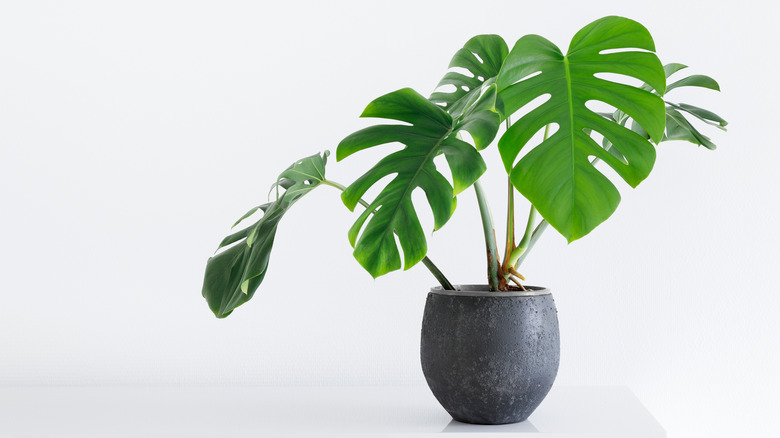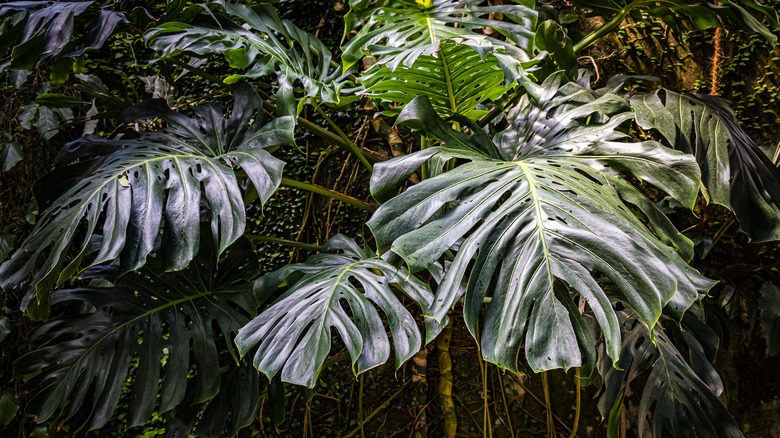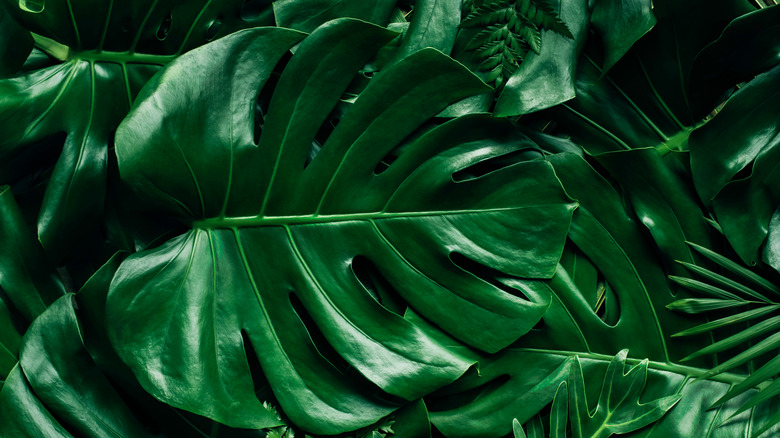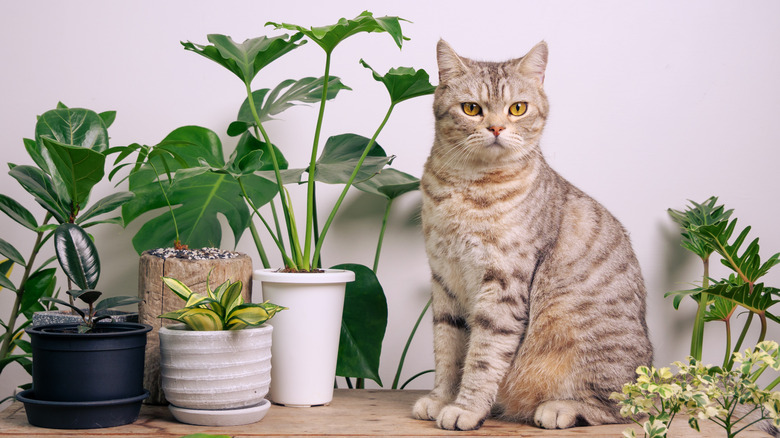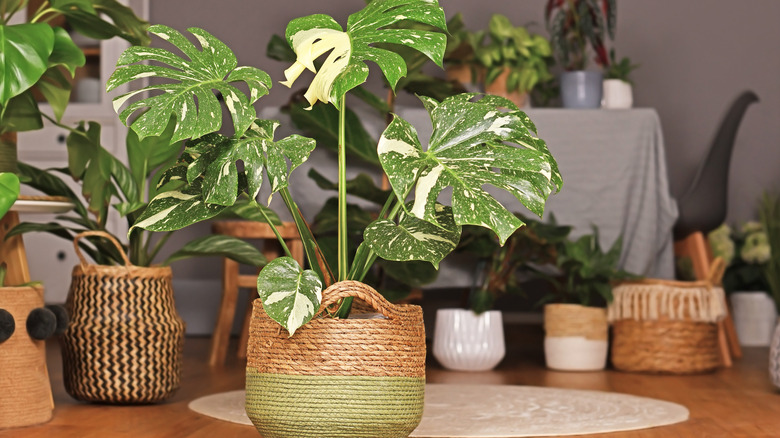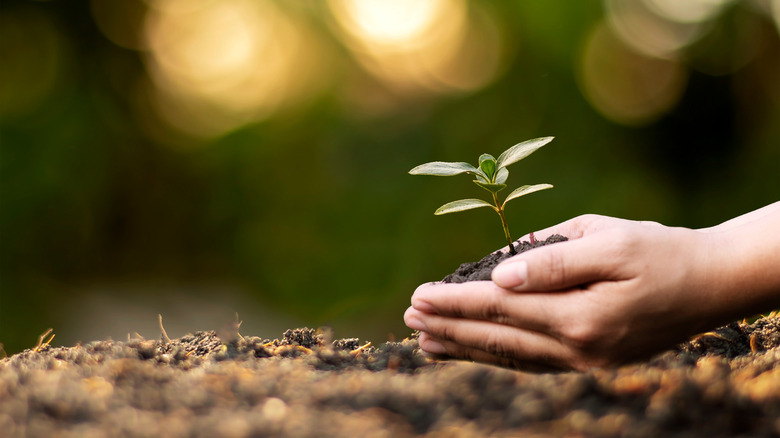How To Successfully Grow And Maintain A Swiss Cheese Plant
Technically known as Monstera deliciosa, or split-leaf philodendron, the Swiss cheese plant makes a popular houseplant because of its striking appearance. The plant has large, heart-shaped green leaves perforated with holes that make it look like Swiss cheese (hence the nickname). It's native to rainforests and mountain areas in Central America and Mexico, according to Gardener's Path, but it's also grown as a houseplant.
Monstera deliciosa has been used as an ornamental plant for centuries. The plant is a vigorous grower, but it can also be a bit temperamental. When growing a Swiss cheese plant, it's important to provide the right amount of light, water, and nutrients for optimal development. It's not an easy plant to keep happy, but Monsteras can make great houseplants once you get the hang of them. Here are some tips to help you get started — they should ensure that your Swiss cheese plant will thrive either indoors or outdoors.
How to use a Swiss cheese plant in a garden
Monstera deliciosa is generally grown in a pot so that it can be brought inside during winter, though it can also be grown outdoors in USDA hardiness zones 10 through 12. While these plants rarely flower when grown inside, they might if grown outside.
When growing outdoors, the Monstera deliciosa needs to be placed in partial shade. This means that it should receive a few hours of sunlight every day, but no more than that. According to Den Garden, Monsteras need a nutrient-rich soil, so it's best to supplement ground soil with compost for the best results.
Since Monsteras are vining plants, they will naturally climb any other plant or structure that's near them. For that reason, it's best to plant them far away from anything you don't want them to climb. They will thrive, however, if planted beside tall trees that their vines can climb.
How to grow a Swiss cheese plant
In order to grow a Swiss cheese plan, you'll need well-draining soil, an appropriately-sized planter, and either seeds, seedlings, or cuttings.
Monsteras can easily be propagated using cuttings, which makes this one of the most popular ways to grow them. These cuttings will take root year-round indoors, according to SFGate. Start by watering the plant to ensure it's well-hydrated. Then, simply cut off one of the growing vines where it meets the main stem of the plant (cut right above the node — the point where the leaf grows out of), and then place it in water. Make sure that at least one leaf is still attached to the cutting when you place it in water so that it can photosynthesize.
It's best to use clear glass so that you can see when roots begin forming. They will thrive in a warm, bright area, and can be grown under artificial lights as needed. Change out the water on a regular basis, and after a few weeks you should have some roots forming. When they're at least an inch long, feel free to transfer them into soil.
How to care for a Swiss cheese plant
The ideal light situation for Monstera deliciosa is bright, indirect sunlight, according to The Spruce. Direct sunlight from a south-facing window should be avoided unless it is diffused with a sheer drape. If your Monstera is getting too much light, the leaves will show yellowing, brown spotting, and burning of the leaf tips. Swiss cheese plants can survive in shady locations, according to Bloomscape, but they may not grow as quickly.
The Swiss cheese plant prefers warm temperatures year-round, so keep it away from drafts or air conditioning vents. If you water your plant too much, it can cause root rot. If you water your plant too little, it can lead to leaf drop and dehydration. As a general rule, it's best to water your Monstera on a weekly basis. If you stick your finger in the soil and it feels dry, then it's time to water the Monstera again. The only exception is during winter when temperatures drop and the plant enters its dormant season. In this case, reduce watering to once every two or three weeks. You can use a soil moisture probe if you want to be more accurate in determining when your plant needs water. When you do water this plant, be sure to do so thoroughly; let water drain completely through the soil and don't leave standing water at the bottom of the pot, according to House Beautiful.
Are Swiss cheese plants toxic?
Unfortunately, Swiss cheese plants aren't the best choice for pet owners. The Monstera deliciosa is toxic to both cats and dogs, according to the ASPCA Animal Poison Control Center. Because they contain insoluble calcium oxalates, they can cause symptoms like mouth pain, nausea and vomiting, trouble with swallowing, drooling, and more.
According to the North Carolina State Gardening Extension, Monstera deliciosa is mildly toxic to humans. It contains oxalates in its sap, which may cause eye irritation if you get some on your hands or face when handling this plant. If you get any of the sap into your eyes and experience eye irritation, flush them immediately with water. The fruit contains calcium oxalate crystals which are mildly irritating to humans but can cause issues when eaten in excess. The Swiss cheese plant does not pose any significant health risks for most people. It's important to note that while this plant isn't considered toxic, it is possible for some people to be allergic to it.
How to re-pot a Swiss cheese plant
When it comes time to re-pot your Swiss cheese plant, you'll have to be careful about how you handle it. The good news is that with a little patience, you can re-pot your Monstera and make sure it stays healthy for years to come.
Start by getting a good potting soil mix. You want something that will support the plant's roots but also retain moisture well so the plant doesn't dry out too quickly, according to Gardening Know How. Look for a mix that contains perlite or vermiculite — these substances will help with drainage and aeration at the same time.
First, remove your plant from its old pot. Hold the trunk with one hand, and then turn the pot upside down with your other hand, shaking it gently to loosen the rootball if necessary. Next, trim away any brown or yellow roots that look unhealthy. Now place your plant in its new pot. Fill in around the rootball with fresh soil mix and tamp it down firmly, but don't pack it too tightly — your plant needs room for its roots to grow! Finally, water thoroughly.
How to fertilize a Swiss cheese plant
Like many types of plants, Monsteras are dormant in the winter and grow in the spring and summer. During their growing season, it's important to fertilize them in order to help them thrive. Bob Vila recommends applying a fertilizer with an NPK ratio of 6-12-5 at the beginning of spring and again during summer months to encourage growth and keep plants healthy. The NPK ratio refers to the balance of nitrogen (N), phosphorus (P), and potassium (K) in the fertilizer.
Some potting mixtures already have fertilizer mixed in, and therefore don't require any additional nutrients. If your potting soil doesn't feature an N-P-K ratio, use 1 to 2 tablespoons of fertilizer per plant every six weeks during the spring and summer months. Apply more if you notice any signs of nutrient deficiency, such as yellowing leaves or poor growth rate. If you wish to use organic fertilizers rather than chemical ones, try adding composted manure or fish emulsion around the base of plants every few weeks instead.
